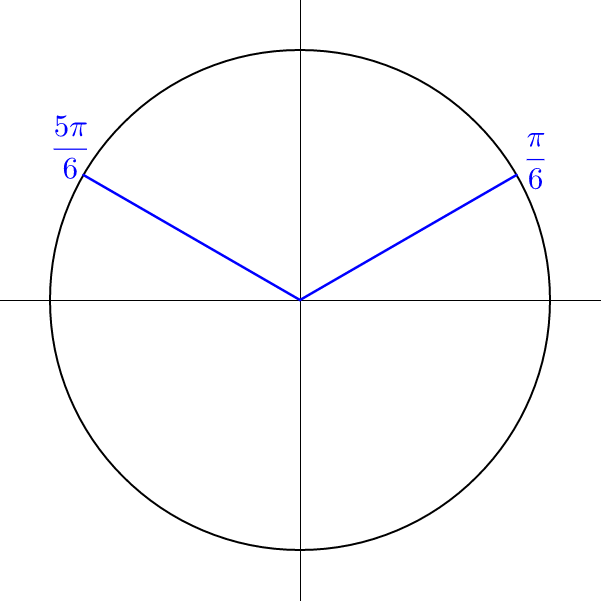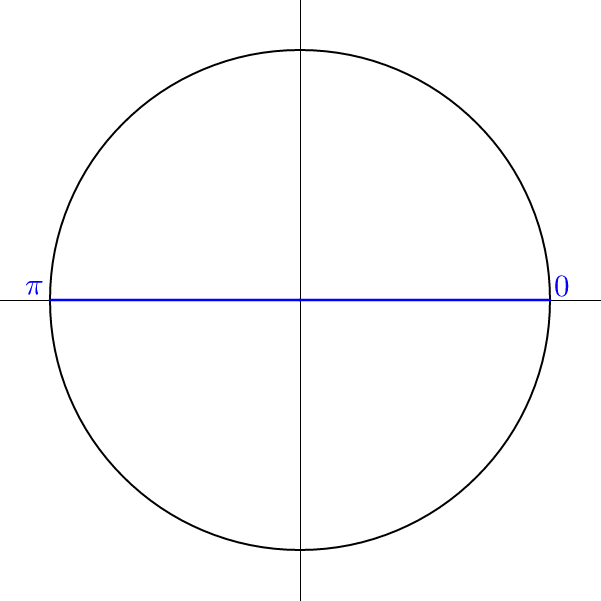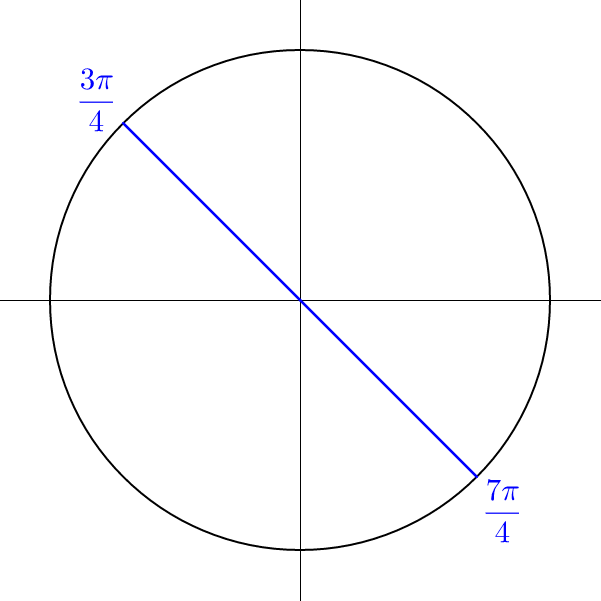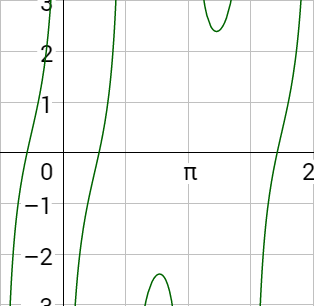Find All Solutions of the Equation Sec2x 2 0
Previous Lesson Table of Contents Next Lesson
5-04 Solve Trigonometric Equations
This is an original lesson based on OpenStax Precalculus lesson 7.5.
Summary: In this section, you will:
- Solve trigonometric simple equations.
- Solve trigonometric equations by factoring.
- Solve trigonometric equations using identities.
- Find all solutions and all solutions on the interval [0, 2π) to trigonometric equations.

In American Football, the quarterback tries to throw the ball to a wide receiver. The equation to model this is \(R = \frac{v^2 \sin 2θ}{32}\) where R is the distance in feet, v is the speed the ball is thrown in feet/second, and θ is the angle above the horizontal that the ball is thrown. If the distance to the receiver and the speed of the throw are known, then the angle that the quarterback has to throw the ball can be calculated.
Solving Trigonometric Equations
The general method to solve trigonometric equations is to isolate a trigonometric expression. This can be done by factoring, using trigonometric identities, or other problem solving techniques.
Several methods to isolate the trigonometric expression are:
- If only one trigonometric expression is present, move everything else to the other side of the equation.
- Factor, then set each factor equal to zero.
- Use trigonometric identities to simplify complex trigonometric expressions.
- If two trigonometric expressions are present and they are related by a Pythagorean identity, then have one expression on each side of the equation and square both sides. Then use the Pythagorean identity to simplify the resulting equation.
After the trigonometric expression is isolated, find the angles that satisfy the trigonometric expression. Remember that each trigonometric function is positive in two quadrants and negative in two quadrants, so there are usually at least two solutions for each trigonometric equation. Because trigonometric functions are periodic, there are an infinite number of solutions that can be found by adding the period of the function.
Find the Solutions of Trigonometric Equations
After the trigonometric expression is isolated, find the angles that satisfy the trigonometric expression. If the results are on the unit circle,
- Think of which angles on the unit circle are solutions to the equation. There are usually two solutions.
- Add the period of the function to each solution multiplied by n, which is an integer.
- If the solutions are not evenly spaced, add 2πn for sine and cosine or πn for tangent.
- If the solutions are evenly spaced around the unit circle, just put the first solution plus the spacing times n such as \(\frac{πn}{3}\).
- If the problem asks for all the solution on the interval [0, 2π), substitute values for n starting with 0 to find all the solution between 0 and 2π.
Example 1: Solve a Simple Trigonometric Equation
Find all solutions of \(2 \sin x - 1 = 0\).
Solution
There is only one trigonometric function, so isolate it and solve.
$$2 \sin x - 1 = 0$$
$$2 \sin x = 1$$
$$\sin x = \frac{1}{2}$$
Think of the angles on the unit circle where \(\sin x = \frac{1}{2}\).

The angles are \(x = \frac{π}{6}, \frac{5π}{6}\). These are not spaced evenly, so add the period times n.
All the solutions are \(x = \frac{π}{6} + 2πn\) and \(\frac{5π}{6} + 2πn\).
Try It 1
Solve \(2 \cos α + \sqrt{2} = 0\).
Answer
\(\frac{3π}{4} + 2πn, \frac{5π}{4} + 2πn\)
Example 2: Solve a Trigonometric Equation by Factoring
Find all solutions of \(\sin x \tan x + \sin x = 0\).
Solution
Begin by factoring out the common factor, sin x.
$$\sin x \tan x + \sin x = 0$$
$$\sin x\left(\tan x + 1\right) = 0$$
Apply the zero product property and set each factor equal to zero and solve.
| $$\sin x = 0$$ | $$\tan x + 1 = 0$$ |
| $$\tan x = -1$$ | |
| Find the solutions on the unit circle | |
| $$x = 0, π$$ | $$x = \frac{3π}{4}, \frac{7π}{4}$$ |
 |  |
| Both sets of solutions are spaced evenly around the unit circle with π between them. | |
| $$x = 0 + πn$$ | $$x = \frac{3π}{4} + πn$$ |
| $$x = πn$$ | |
The solutions are \(x = πn, \frac{3π}{4} + πn\).
Try It 2
Solve \(\tan x \sec x - \tan x = 0\).
Answer
πn
Example 3: Solve a Trigonometric Equation by Factoring
Find all solutions of \(2 \cos^2 α + \cos α - 1 = 0\).
Solution
This is a quadratic type equation, so factor it as you would quadratic trinomial.
$$2 \cos^2 α + \cos α - 1 = 0$$
$$\left(2 \cos α - 1\right)\left(\cos α + 1\right) = 0$$
Set each factor equal to zero and solve.
These solutions are evenly spaced around the unit circle with \(\frac{2π}{3}\) between each angle, so the solutions can be written as \(α = \frac{π}{3} + \frac{2πn}{3}\).
Try It 3
Solve 2 sin2 x − sin x − 1 = 0.
Answer
\(\frac{π}{2} + \frac{2πn}{3}\)
Example 4: Solve a Trigonometric Equation Using an Identity
Find all the solutions on the interval [0, 2π) of \(\sec^2 β + \tan^2 β = 7\).
Solution
A Pythagorean identity allows the substitution of \(\tan^2 β + 1\) for \(\sec^2 β\).
$$\sec^2 β + \tan^2 β = 7$$
$$\tan^2 β + 1 + \tan^2 β = 7$$
$$2\tan^2 β + 1 = 7$$
$$2\tan^2 β = 6$$
$$\tan^2 β = 3$$
$$\tan β = ±\sqrt{3}$$
$$β = \frac{π}{3}, \frac{2π}{3}, \frac{4π}{3}, \frac{5π}{3}$$
$$β = \frac{π}{3} + πn, \frac{2π}{3} + πn$$
Since only solutions between 0 and 2π are asked for, the solutions can be found by plugging in integers for n starting with 0 until the results are 2π or larger. This gives solutions of \(β = \frac{π}{3}, \frac{2π}{3}, \frac{4π}{3}, \frac{5π}{3}\).
Try It 4
Solve on the interval [0, 2π): sin2 x − cos2 x = 0.
Answer
\(\frac{π}{4}, \frac{3π}{4}, \frac{5π}{4}, \frac{7π}{4}\)
Example 5: Solve a Trigonometric Equation Using an Identity
Find all the solutions on the interval [0, 2π) of \(\sec θ \cot θ = 1\).
Solution
Because the trigonometric expressions do not equal 0, we cannot use the zero product property, so the expression will have to be simplified. Try rewriting the expression in terms of sine and cosine.
$$\sec 2θ \cot 2θ = 1$$
$$\frac{1}{\cos 2θ} \frac{\cos 2θ}{\sin 2θ} = 1$$
$$\frac{1}{\sin 2θ} = 1$$
$$1 = \sin 2θ$$
The angle in the equation is 2θ.
$$2θ = \frac{π}{2} + 2πn$$
$$θ = \frac{π}{4} + πn$$
Plug in integers starting with 0 for n until the results are 2π or higher.
$$θ = \frac{π}{4}, \frac{5π}{4}$$
Try It 5
Solve on the interval [0, 2π): \(2\cos 3x = \sqrt{3}\).
Answer
\(\frac{π}{18}\) \(\frac{11π}{18}\), \(\frac{13π}{18}\), \(\frac{23π}{18}\), \(\frac{25π}{18}\), \(\frac{35π}{18}\)
Example 6: Solve a Trigonometric Equation by Squaring Both Sides
Find all the solutions on the interval [0, 2π) of \(\csc 3x + \cot 3x = 1\).
Solution
Cosecant, cotangent, and 1 are related with a Pythagorean identity, but the problem does not have squares on the trigonometric functions. To fix this, move the cotangent to other side of the equation and square both sides.
$$\csc 3x + \cot 3x = 1$$
$$\csc 3x = 1 - \cot 3x$$
$$\csc^2 3x = \left(1 - \cot 3x\right)^2$$
$$\csc^2 3x = 1 - 2\cot 3x + \cot^2 3x$$
Apply the Pythagorean identity for cosecant and cotangent to the csc2 3x. That way cotangent will be the only trigonometric function in the equation.
$$1 + \cot^2 3x = 1 - 2\cot 3x + \cot^2 3x$$
Subtract 1 and cot2 3x from both sides.
$$0 = -2\cot 3x$$
$$0 = \cot 3x$$
The angle in the equation is 3x.
$$3x = \frac{π}{2} + πn$$
$$x = \frac{π}{6} + \frac{πn}{3}$$
Plug in integers starting with 0 for n until the results are 2π or higher.
$$x = \frac{π}{6}, \frac{π}{2}, \frac{5π}{6}, \frac{7π}{6}, \frac{3π}{2}, \frac{11π}{6}$$
Try It 6
Solve on the interval [0, 2π): cos 2x – sin 2x = 1.
Answer
0, \(\frac{3π}{4}\), π, \(\frac{7π}{4}\)
Example 7: Solve a Trigonometric Equation by Graphing
Use a graphing utility to find all the solutions in the interval [0, 2π) to three decimal places of tan x = csc x.
Solution
Make the equation equal 0, then graph the expression. Use the calculate zero feature to find the x-intercepts.
On a TI graphing calculator, press Y= and type in the expression. Then press ZOOM and choose ZTrig from the menu. This gives a nice graph on the interval [−2π, 2π]. To find the x-intercepts, press 2nd CALC and choose zero from the menu. Use the left and right arrow keys to move the cursor to the left of an intercept and press enter. Then move the cursor to the right of the intercept and press enter. Finally move the cursor to the approximate intercept to make a guess and press enter. The intercept will be displayed on the bottom of the screen.

The x-intercepts and solutions are x = 0.905 and x = 5.379.
Try It 7
Solve on the interval [0, 2π) using a graphing utility: sin2 x + sin x = 0.
Answer
0, 3.142, 4.712
Practice Exercises
- Describe how to find all solutions in the interval [0, 2π) when the angle is 3θ. (RW)
- \(2 \cos x - \sqrt{2} = 0\)
- \(\csc x - 2 = 0\)
- \(9 \tan^2 x - 3 = 0\)
- \(\sin x \cos x + \sin x = 0\)
- \(\cos x - \cos^2 x = 0\)
- \(\csc^2 x - 3 \csc x + 2 = 0\)
- \(2 \sin^2 3x - \sin 3x - 1 = 0\)
- \(\csc^2 x + \cot^2 x = 3\)
- \(2 \sin 2x \cot 2x = \sqrt{3}\)
- \(\cot^2 \left(\frac{π}{2} - 2x\right) = 3\)
- \(\sin x + \cos x = 1\)
- \(\sin x + \cos^2 x = 0\)
- \(\sec^2 x + \sec x - 2 = 0\)
- When the initial height and final height of a projectile are equal, then the distance, or range, of the projectile is modeled y \(R = \frac{v^2 \sin 2θ}{32}\) where R is the range in feet, v is the initial speed in feet per second, and θ is the launch angle. If a football receiver is 20 yards away from the quarterback and the ball is thrown at 50 ft/s, what angle should the ball be thrown?
- (5-03) Verify \(\cos\left(-x\right)\sec\left(\frac{π}{2} - x\right) = \cot x\).
- (5-03) Verify \(\sin^3 x - \sin x = -\cos^2 x \sin x\).
- (5-02) Simplify using identities: \(\left(3 - 3\sin x\right)\left(3 + 3\sin x\right)\).
- (5-01) Use the given values to evaluate all six trigonometric functions: \(\sin x = \frac{7}{25}, \tan x < 0\).
- (4-09) Find the exact value, if possible, without a calculator: \(\sin \left(\cos^{−1} \frac{5}{13}\right)\).
Find all solutions of the following equations. (RW)
Find all solutions in the interval [0, 2π). (RW)
Use a graphing utility to find the solutions in the interval [0, 2π) to three decimal places. (RW)
Real life problems (RW)
Mixed Review (RW)
Answers
- Find the expression for all the solutions and then plug in values for n starting with 0 until the angle is greater than 2π.
- \(\frac{π}{4} + 2πn, \frac{7π}{4} + 2πn\)
- \(\frac{π}{6} + 2πn, \frac{5π}{6} + 2πn\)
- \(\frac{π}{6} + πn\)
- πn
- \(\frac{π}{2} + πn, 2πn\)
- \(\frac{π}{6} + 2πn, \frac{5π}{6} + 2πn, \frac{π}{2} + 2πn\)
- \(\frac{π}{6}, \frac{7π}{18}, \frac{11π}{18}, \frac{5π}{6}, \frac{19π}{18}, \frac{23π}{18}, \frac{3π}{2}, \frac{31π}{18}, \frac{35π}{18}\)
- \(\frac{π}{4}, \frac{5π}{4}\)
- \(\frac{π}{12}, \frac{11π}{12}, \frac{13π}{12}, \frac{23π}{12}\)
- \(\frac{π}{6}, \frac{π}{3}, \frac{2π}{3}, \frac{5π}{6}, \frac{7π}{6}, \frac{4π}{3}, \frac{5π}{3}, \frac{11π}{6}\)
- \(0, \frac{π}{2}\)
- 3.808, 5.617
- 0, 2.094, 4.189
- 25.1°, 64.9°
- \(\cos\left(-x\right)\sec\left(\frac{π}{2}-x\right)\) \(= \cos x \csc x\) \(= \frac{\cos x}{\sin x}\) \(= \cot x\)
- \(\sin^3 x - \sin x\) \(= \sin x\left(\sin^2 x - 1\right)\) \(= \sin x \left(1 - \cos^2 x - 1\right)\) \(= \sin x\left(-\cos^2 x\right)\) \(= -\cos^2 x \sin x\)
- \(9 \cos^2 x\)
- \(\cos x = -\frac{24}{25}\), \(\tan x = -\frac{7}{24}\), \(\csc x = \frac{25}{7}\), \(\sec x = -\frac{25}{24}\), \(\cot x = -\frac{24}{7}\)
- \(\frac{12}{13}\)
Find All Solutions of the Equation Sec2x 2 0
Source: https://www.andrews.edu/~rwright/Precalculus-RLW/Text/05-04.html